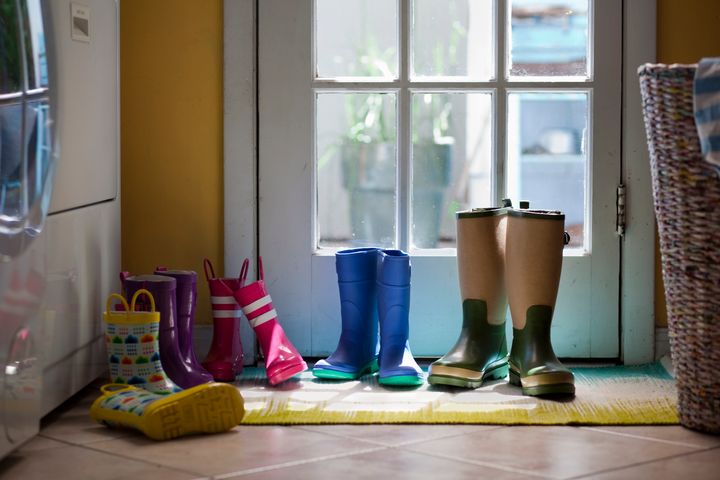It’s not rare to see a shoe rack or shoe mat at the entryway of someone’s home. Some people do it for comfort, some do it for cultural reasons, and others do it for cleanliness.
When it comes to cleanliness, it’s because we’re told from a young age that the bottom of our shoes are filthy — but just how filthy?
“The first thing I would say is that the average person doesn’t realize that we live in a very germy world. We do not put ourselves or our environment into a [sterilizer] every morning,” said Dr. William Schaffner, a professor of infectious diseases at Vanderbilt University Medical Center in Nashville.
In other words, your shoes may have bacteria on them, but so does the rest of you.
So, how worried do you need to be about the bottom of your shoes? Do you really need to take them off for cleanliness reasons before walking into your house? Here’s what experts say:
Overall, the surface of the bottom of your shoes is small compared to other vessels for infection.
Everything is context-dependent, said Jack Gilbert, a professor of pediatrics at the University of California San Diego School of Medicine and an expert in microbial ecology who co-authored “Dirt Is Good.” If you find yourself in a high-risk viral research lab laden with infectious diseases, you won’t want to wear your shoes in your home. But, for the vast majority of people, the risk of infecting yourself or someone else in your home from bacteria on your shoes is very, very low, he said.
And it’s worth noting that there is risk associated with bringing another human being into your home, too. This is because every human releases about 30 million bacterial cells each hour just by standing in a room, Gilbert said.
“You’re breathing them out; they’re being shed from your skin and your hair,” Gilbert said. “You’re literally releasing a microbial cloud into every environment you stand in.”
While this doesn’t sound pleasant, it is perfectly normal. Our homes are full of the bacteria that each person within the home sheds.
What’s more, a study Gilbert led found that the microorganisms on the bottoms of shoes were “completely transformed with every new environment it went into.” So, as soon as someone steps into your home ― which is already full of your own microbes ― the bottoms of their shoes will take on the microbes that make up your space.
“The small surface area of the bottom of your shoe is just not a particular threat to the health and well-being of the people in your home,” he added.
Some bacteria are even good for you.
According to Gilbert, younger siblings of school-going children often have a stronger immune system and are less likely to develop allergies because of the viruses, bacteria and fungi that older siblings bring home from school, including those we may carry on our shoes.
“The microbes that they would bring into the home could have a beneficial impact on the immune system of the occupants,” Gilbert said.
One study did find that the bottoms of shoes can be contaminated with bacteria like E. coli, which sounds alarming. But Gilbert said when it comes to the risk of actually consuming that E. coli, it’s low.
“There is not a single recorded incident of anybody getting a pathogenic infection from residual dog poop that could have been walked into a home or even transmitted into a home from another person,” he said.
And while hospital floors are known to be contaminated, Gilbert said it’s also not cause for concern even if someone in your home works in a hospital. Between walking from a hospital, to a parking lot, to a car, onto the grass and into a home, much of the bacteria on a shoe is being literally stomped away, he said. So the likelihood of getting sick from contaminated shoes is low.
“There’s no such thing as zero, but the probability is so low it’s something that nobody should ever really be worried about,” Gilbert said.
Bacteria from shoe bottoms aren’t the reason you get sick. It’s dirty hands.
The reality is that there is bacteria all around us, whether it’s on shoes, mail, clothing or money — there is no getting rid of it. Schaffner said the way bacteria tends to spread is via our hands and fingers.
“And so the great emphasis has been on hand-washing, hand hygiene, to try to interrupt picking up bacteria or viruses from some inanimate surface and then transferring those germs to our lips, nose, eyes and the like,” Schaffner said.
He added that there just isn’t research that shows people getting sick from viruses that are tracked inside from the bottoms of shoes.
“If there were firm scientific data indicating that we could track [bacteria] into our homes, businesses, schools, religious venues, concerts … that could be picked up by humans and subsequently make them sick, why is it that we don’t have constant public health messages in that regard?” Schaffner said.
If this were a way that sickness spread, you’d be told time and time again to take off your shoes — just like you’re told to wash your hands, stay home if you’re sick and wear a mask in crowded indoor spaces to stop the spread of viruses like COVID-19.
Kinzie Riehm via Getty Images
There are some non-germ reasons to take off your shoes.
Some people take off their shoes for cultural reasons. Doing this is common in parts of Asia, the Middle East and Eastern Europe. Gilbert added that while it is a sign of respect, it may have also stemmed from germ transmission, too, in certain areas like Japan.
“It appears to have originated with an understanding that it was inappropriate to bring dirt into one’s house because controlling one’s house and reducing the amount of germs is considered an honorable thing to do,” Gilbert said.
Taking off your shoes is also a way to keep light-colored floors and carpets clean. “You can bring things into your home and track it over your carpet and your floor and make a mess,” Schaffner said.
To avoid this, you can take off your shoes — but both experts stressed it has nothing to do with bacteria spread. “It’s just humans wanting to make things look nice … rather than anything else,” Gilbert explained.
“I can provide assurance that these respiratory viruses … are not spread by having them picked up on the soles of the feet and transmitted into the households,” Schaffner added.


